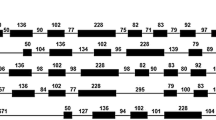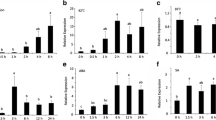Abstract
A low-temperature-responsive gene, blt 801, isolated from a winter barley (Hordeum vulgare L.) cDNA library prepared from leaf meristematic tissue, was sequenced. The deduced amino acid sequence predicts a glycine-rich RNA-binding protein (GR-RNP) which was homology to stress-responsive GR-RNPs from several other plant species. BLT 801 is a two-domain protein, the amino-terminal domain comprises a consensus RNA-binding domain similar to that found in many eukaryotic genes and the carboxy-terminal domain is extremely glycine-rich (68.5% glycine). Blt 801 mRNA also accumulates in response to the phytohormone abscisic acid. The protein encoded by blt 801 has been produced as a recombinant fusion protein using a bacterial expression vector. The fusion protein, a chimaera of glutathione S-transferase and BLT 801, has been used in studies to determine nucleic acid binding and other characteristics. Binding studies with single-stranded nucleic acids show that BLT 801 has affinity for homoribopolymers G, A and U but not C, it also binds to single-stranded DNA and selects RNA molecules containing open loop structures enriched in adenine but low in cytosine. BLT 801 has a consensus motif for phosphorylation by cAMP protein kinase (PKA) at the junction between the two domains which can be phosphorylated by PKA in vitro and which, by analogy to animal studies, may have significance for controlling enzyme function.
Similar content being viewed by others
References
Albà MM, Culiánez-Macia FA, Godeny A, Freire MA, Nadal B, Pagès M: The maize RNA-binding protein, MA16, is a nucleolar protein located in the dense fibrillar component. Plant J 6: 825–834 (1994).
Bandziulis RJ, Swanson MS, Dreyfuss G: RNA-binding proteins as developmental regulators. Genes Devel 3: 431–437 (1989).
Bergeron D, Beauseigle D, Bellemare G: Sequence and expression of a gene encoding a protein with RNA-binding and glycine-rich domains in Brassica napus. Biochim Biophys Acta 1216: 123–125 (1993).
Burd CG, Dreyfuss G. RNA binding specificity of hnRNP A1: significance of hnRNP A1 high affinity binding sites in pre-mRNA splicing. EMBO J 13: 1197–1204 (1994).
Carpenter CD, Kreps JA, Simon AE: Genes encoding glycine-rich Arabidopsis thaliana proteins with RNA-binding motifs are influenced by cold treatment and an endogenous circadian rhythm. Plant Physiol 104: 1015–1025 (1994).
Cobianchi F, Karpel RL, Williams KR, Notario V, Wilson SH: Mammalian heterogeneous nuclear ribonucleoprotein complex protein A1. J Biol Chem 263: 1063–1071 (1988).
Cobianchi F, Calvio C, Stoppini M, Buvoli M, Riva S: Phosphorylation of human hnRNP protein A1 abrogates in vitro strand annealing activity. Nucl Acids Res 21: 949–955 (1993).
Crétin C, Puigdomènech P: Glycine-rich RNA-binding proteins from Sorghum vulgare. Plant Mol Biol 15: 783–785 (1990).
de Oliveira DE, Seurinck J, Inze D, Van Montagu M, Botterman J: Differential expression of five Arabidopsis genes encoding glycine-rich proteins. Plant Cell 2: 427–436 (1990).
de Oliveira DE, Franco LO, Simoens C, Seurinck J, Coppieters J, Bottermen J, Van Montagu M: Inflorescence specific genes from Arabidopsis thaliana encoding glycine-rich proteins. Plant J 3: 495–507 (1993).
Didierjean L, Frendo P, Burkard G: Stress responses in maize: sequence analysis of cDNAs encoding glycine-rich proteins. Plant Mol Biol 18: 847–849 (1992).
Dreyfuss G, Swanson MS, Piñol-Roma: Heterogeneous nuclear ribonucleoprotein particles and the pathway of mRNA formation. Trends Biochem Sci 13: 86–91 (1988).
Dreyfuss G, Matunis MJ, Piñol-Roma S, Burd CG: hnRNP proteins and the biogenesis of mRNA. Annu Rev Biochem 62: 289–321 (1993).
Dunn MA, Hughes MA, Pearce RS, Jack PL: Molecular characterisation of a barley gene induced by cold treatment. J Exp Bot 41: 1405–1413 (1990).
Dunn MA, Hughes MA, Zhang L, Pearce RS, Quigley AS, Jack PL: Nucleotide sequence and molecular analysis of the low temperature induced cereal gene, BLT 4. Mol Gen Genet 229, 389–394 (1991).
Dunn MA, Goddard NJ, Zhang L, Pearce RS, Hughes MA: Low-temperature-responsive barley genes have different control mechanisms. Plant Mol Biol 24: 879–888 (1994).
Fang R-X, Pang Z, Gao D-M, Mang K-Q, Chua N-H: cDNA sequence of a virus-inducible, glycine-rich protein from rice. Plant Mol Biol 17: 1255–1257 (1991).
Felsenstein J: PHYLIP—Phylogeny inference package (version 3.2). Cladistics 5: 164–166 (1989).
Gómez J, Sánchez-Martinez D, Stiefel V, Rigan J, Puigdomènech P, Pagès M: A gene induced by the plant hormone abscisic acid in response to water stress encodes a glycine-rich protein. Nature 334: 262–264 (1988).
Hajela RK, Horvath DP, Gilmour SJ, Thomashow MF: Molecular cloning and expression of cor (cold-regulated) genes in Arabidopsis thaliana. Plant Physiol 93: 1246–1252 (1990).
Haynes SR, Raychaudhiri G, Beyer AL: The Drosophila Hrb 98DE locus encodes four protein isoforms homologous to the A1 protein of mammalian nuclear ribonucleoprotein complexes. Mol Cell Biol 10: 316–323 (1990).
Heintzen C, Melzer S, Fischer R, Kappeler S, Apel K, Staiger D. A light- and temperature- entrained circadian clock controls expression of transcripts encloding nuclear proteins with homology to RNA-binding proteins in meristematic tissue. Plant J 5: 799–813 (1994).
Higgins DG, Fuchs R, Bleasby AJ: CLUSTAL V: improved software for multiple sequence alignment. Comput Appl Biosci 8.
Hilson P, Carroll KL, Masson PH: Molecular characterisation of PAB2, a member of the multigene family coding for poly(A)-binding proteins in Arabidopsis thaliana. Plant Physiol 103: 525–533 (1993).
Hirose T, Sugita M, Sugiura M: cDNA structure, expression and nucleic acid-binding properties of three RNA-binding proteins in tobacco: occurrence of tissue-specific alternative splicing. Nucl Acids Res 21: 3981–3987 (1993).
Hughes MA, Dunn MA, Pearce RS, White AJ, Zhang L: An abscisic-acid-responsive, low temperature barley gene has homology with a maize phospholipid transfer protein. Plant Cell Env: 15: 861–865 (1992).
Hughes MA, Dunn MA, Zhang L, Pearce RS, Goddard NJ, White AJ: Long-term adaptation and survival. In Fowden L, Mansfield T, Stoddart J (eds) Plant Adaptation to Environmental Stress, pp. 251–262. Chapman & Hall, London (1993).
Hughes MA, Dunn MA: The molecular biology of plant acclimation to low temperature. J Exp Bot (in press).
Hughes MA, Pearce RS: Low temperature treatment of barley plants causes altered gene expression in shoot merstems. J Exp Bot 39: 1461–1467 (1988).
Keller B, Sauer N, Lamb CJ: Glycine-rich cell wall proteins in bean: gene structure and association of the protein with the vascular system. EMBO J 7: 3625–3633 (1988).
Kemp BE, Pearson RB: Protein kinase recognition sequence motifs. Trends Biochem Sci 15: 342–346 (1990).
Kenan DJ, Query CC, Keene JD: RNA recognition: towards identifying determinants of specificity. Trends Biochem Sci 16: 214–220 (1991).
Lei M, Wu R: A novel glycine-rich cell wall protein in rice. Plant Mol Biol 16: 187–198 (1991).
Li Y, Suguira M: Three distinct ribonucleoproteins from tobacco chloroplasts: each contains a unique amino terminal acidic domain and two ribonucleoprotein consensus motifs. EMBO J 9: 3059–3066 (1990).
Ludevid MD, Freire MA, Gómez J, Burd CG, Albericio EG, Dreyfuss G, Pagès M: RNA binding characteristics of a 16 kDa glycine-rich protein from maize. Plant J 2: 999–1003 (1992).
Rohde W, Rosch K, Kröger K, Salamini F: Nucleotide sequence of a Hordeum vulgare gene encoding a glycine-rich protein with homology to vertebrate cytokeratins. Plant Mol Biol 14: 1057–1059 (1990).
Sambrook J, Fritsch EF, Maniatis T: Molecular Cloning: A Laboratory Manual. Cold Spring Harbor Laboratory Press, Cold Spring Harbor, NY (1989).
Soulard M, Valle VD, Suomi MC, Piñol-Roma S, Codogno P, Banoy C, Bellini M, Lacroix J-C, Monod G, Dreyfuss G, Larson C-J: hnRNP G: sequence and characterisation of a glycosylated RNA-binding protein. Nucl Acids Res 21: 4210–4217 (1993).
Stone JM, Walker JC: Plant Protein kinase families and signal transduction. Plant Physiol 108: 451–457 (1995).
Sturm A: A wound-inducible glycine-rich protein from Daucus carota with homology to single-stranded nucleic acid-binding proteins. Plant Physiol 99: 1689–1692 (1992).
Swanson MS, Dreyffuss G: Classification and purification of proteins of heterogeneous nuclear ribonucleoprotein particles by RNA-binding specificities. Mol Cell Biol 8: 2237–2241 (1988).
Tsai DE, Harper DS, Keene JD: U1-snRNP-A protein selects a ten nucleotide consensus sequence from a degenerate RNA pool presented in various structural contexts. Nucl Acids Res 19: 4931–4936 (1991).
Tuerk C, Gold L: Systematic evolution of ligands by exponential enrichment: RNA ligands to bacteriophage T4 DNA polymerase. Science 249: 505–510 (1990).
van Nocker S, Vierstra RD: Two cDNAs from Arabidopsis thaliana encode putative RNA-binding proteins containing glycine-rich domains. Plant Mol Biol 21: 693–699 (1993).
Wolfraim LA, Langis R, Tyson H, Dhinsda RS: cDNA sequence expression and transcript stability of a cold acclimation-specific gene cas 18 of alfalfa (Medicago falcata) cells. Plant Physiol 101, 1275–1282 (1993).
Yang J, Hunt AG: Purification and characterisation of a 70-kilodalton polyadenylate-binding protein from pea (Pisum sativum). Plant Physiol 98: 1115–1120 (1992).
Author information
Authors and Affiliations
Rights and permissions
About this article
Cite this article
Dunn, M.A., Brown, K., Lightowlers, R. et al. A low-temperature-responsive gene from barley encodes a protein with single-stranded nucleic acid-binding activity which is phosphorylated in vitro . Plant Mol Biol 30, 947–959 (1996). https://doi.org/10.1007/BF00020806
Received:
Accepted:
Issue Date:
DOI: https://doi.org/10.1007/BF00020806




